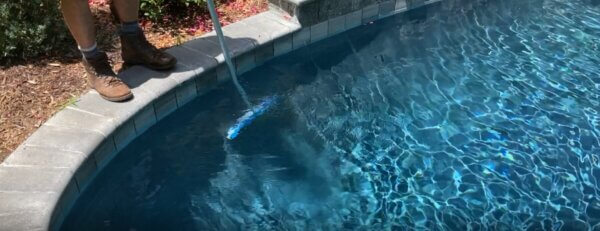Why Testing Your Pool Water is Important
As a pool owner, regularly testing the water in your pool is one of the most important maintenance tasks you will perform. Testing enables you to verify that the water chemistry is balanced, which ensures that the water stays clear, safe, and healthy for swimmers. In addition, proper water chemistry will help protect your pool interior finish and mechanical equipment from damage.
When testing your pool water, it is essential to check the levels of these four factors:
- Free chlorine. Chlorine kills a variety of bacteria, viruses, and organic matter, such as sweat, that comes from swimmers’ bodies. Some of these pathogens—including E. coli and giardia—can make swimmers very sick, which is why it is crucial to maintain proper levels of chlorine in your pool. In addition, chlorine helps ward off algae, which can cause slimy patches to grow and the water to take on an off-putting greenish hue. Having too much chlorine, however, can irritate swimmers’ eyes, skin, and respiratory systems. To keep your pool properly sanitized while still being comfortable for swimmers, the level of free chlorine—which refers to chlorine that has yet to react with the pool water or contaminants—should be between one and three parts per million (ppm). It is recommended that you check this level and add chlorine as needed two to three times per week, although you may need to do so more frequently if your pool is being used heavily.
- A pool’s pH level represents the acidity of the water. If the pH is above 8.0, the water is considered basic and may become cloudy and irritating to swimmers’ skin and eyes. Basic pH levels can also negate the impact of chlorine, making the water unsafe for swimming. A pH below 7.0, on the other hand, indicates that the water is acidic. In addition to causing irritation to swimmers, acidic water can damage the pool’s interior finish, pump, heaters, and other equipment. The optimal pH for a pool is between 7.4 and 7.6; to keep this level within range, test your pool’s pH approximately two to three times per week.
- Calcium hardness. Testing calcium hardness determines whether your pool water is too soft or too hard. If it’s too soft, the water may begin to absorb calcium from the pool plaster, causing it to become damaged and pitted. If calcium levels are high and the water is too hard, calcium deposits may build up on the pool’s surface, resulting in unsightly white, gray, or brown spots. To prevent this and other costly problems, test calcium hardness at least once a month to ensure that it is between 200 and 500 ppm.
- Total alkalinity. The total amount of alkaline in your pool has a direct impact on pH levels. When alkalinity deviates from the recommended range of 90 to 120 ppm, pH levels may begin to drift towards basic or acidic. Low alkalinity is particularly harmful, causing dark, cloudy water, irritation to swimmers’ eyes, and damage to the pool equipment. High alkalinity can also cause irritation and may reduce the effectiveness of chlorine. Your pool’s alkalinity should be tested approximately once a week.
While many homeowners test the pool water on their own using test strips or liquid test kits, taking a sample to a pool professional provides the most thorough and accurate results. At Aqua Pool & Patio, we are pleased to offer free water testing to local residents. Simply bring in a sample of your pool water to our location in East Windsor, CT, and we will test the water chemistry and provide recommendations on how to improve the safety and clarity of your pool. Visit our maintenance page to learn more!









